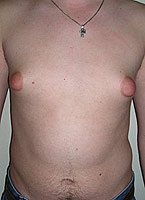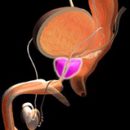What is gynecomastia? How is the treatment of gynecomastia? What are the methods of correction? Answers to these questions you will find in the article.
Content
What is gynecomastia
Gynecomastia (Gynaecomastia: Greek. Gyne, Gynaikos Woman + Mastos
breasts) - an increase in one or both mammary glands in men. Distinguish
True gynecomastia and false, or pseudoginetics. With true
Gynecomastia Milk glands increase as a result of hyperplasia
shared Milky Duks and Hypertrophy of the Connective Tissue of the gland, and
with pseudoginetics - due to excessive fat deposit in subcutaneous
fiber (usually when obesity).
One of the most
Often found forms of true gynecomastia is puberty or
Youth gynecomastia that occurs during puberty at
Normal sexual development. This form of gynecomastia is characterized
The appearance of subareolar one-sided or double-sided swelling,
Often pretty painful. This swelling can disappear by
the end of the puberty period, but in some cases it is maintained
Adults. The cause of gynecomastia in the pubertal period is unknown, however
It is assumed that it is the result of a temporary imbalance between
Synthesis of genital hormones (estrogen, androgen) and gonadotropic
hormones, as well as increasing the concentration of prolactin and
Estandiol. Most young men with puberty gynecomastia
The increase in the mammary glands is so insignificant that treatment is not
requires, and only approximately 7-8% of patients over 3 years
Large sizes of the mammary glands are preserved, which may be injured
Psyche of a young man.

True gynecomastia
It is also noted under a number of diseases characterized by imbalance
between the synthesis of estrogen, androgen, prolactin and gonadotropic
hormones (for example, under hermaphroditis, clanfelter syndrome, etc.).
Family forms of true gynecomastia are described, among which they distinguish
gynecomastia combined with testicular atrophy and transmitted on women's
lines, and gynecomastia without tummy atrophy, which is transmitted by male
lines.
The special form of family gynecomastia is
so called rapenstein syndrome - gynecomastia combined with
Hypospandia. Gynecomastia with hyperprolactinemia is combined with
oligospermia and sexual impotence. With this form of gynecomastia sometimes
Detect a change in the shape of the Turkish saddle, the symptoms mark
Defeat of the Central Nervous System.
Gynecomastia
often occurs in hormonal and active adrenal tumors and
Eggs producing estrogens, with prostate adenoma.
Gynecomastia develops with diseases accompanied by
intoxication or impaired metabolic processes in the body,
Disproteinmia, protein starvation, diabetes, diffuse
toxic zob, pulmonary tuberculosis, cardiovascular
deficiency treated digitalis (more often in reducing
period). In chronic diseases of the liver, gynecomastia arises due to
increasing the concentration of estrogen in the blood caused what is
Perversion of metabolism steroids in the liver.
Special
The form is gynecomastia with alcoholic cirrhosis of the liver (syndrome
Silvestrini - Cords), this syndrome also includes hypogonadism and
Semi impotence. Gynecomastia may appear after treatment with drugs,
influencing the fabric receptors of the mammary glands to estrogen,
Increasing their products or products of gonadotropins and prolactin:
estrogen, testosterone, chorionic gonadotropin,
Phenothiazidami. reserpine, Veroshpiron. In patients with hypothyroidism,
Addison disease Gynecomastia is associated with hormonal imbalance: in the first
case it is a consequence of hyperprolactineia, in the second -
Violations of steroidogenesis in adrenal glands.
Diagnosis
set on the basis of the characteristic appearance of the patient,
Anamnous data (treatment of sex hormones,
Veroshpiron and T.D.), data of biochemical studies.
Methods of treating gynecomastia
Conservative treatment. Conservative
Treatment is carried out outpatient under the supervision of endocrinologist. It depends
from the form of the disease. The need to treat youthful gynecomastia,
The choice of method and the timing of therapeutic measures are dictated
psychological condition of the patient. You can stick to the expectant
Tactics, because most often in 2-3 years at youthful gynecomastia
Spontaneous regression of increased milk glands occurs.
IN
Recent years attempts to affect the pathogenetic
Mechanisms of gynecomastia with drugs overwhelming prolactin secretion
(Parlodel, or Bromcriptein) or stimulating selection
Luteinizing hormone (clomiphene). Parlohel is applied at a dose of 2.5-5 mg per day for 1-6 months.
Operational treatment. With a large volume of the mammary glands and the absence of the effect of
conservative therapy, with intolerance to the drug or the impossibility
Calculate due to psychologically unfavorable situation is recommended
Operational treatment (the removal of the tissue of the mammary glands through perialaria
incision or liposactive method).









